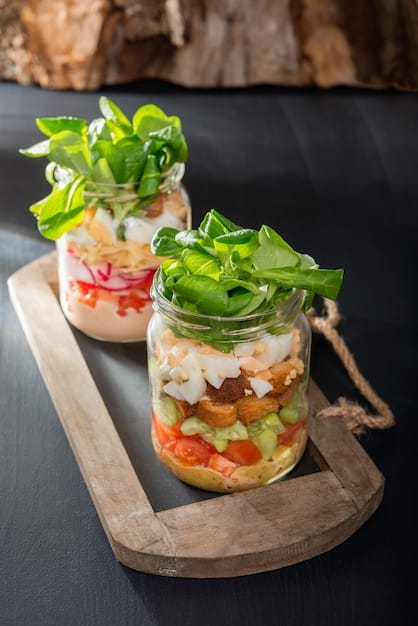Healthy Meal Planning for Busy Professionals: The Complete Guide

Healthy meal planning for busy professionals involves creating a structured approach to preparing nutritious meals in advance, saving time, reducing stress, and promoting better eating habits despite demanding schedules.
For busy professionals, maintaining a healthy lifestyle often feels like an uphill battle. Between long hours, constant meetings, and tight deadlines, the idea of preparing nutritious meals can seem daunting. However, with effective **healthy meal planning for busy professionals**, it’s entirely possible to nourish your body and mind, boosting your productivity and overall well-being.
Why Healthy Meal Planning Matters for Busy Professionals
Healthy meal planning isn’t just about eating well; it’s about reclaiming control over your health amidst a hectic lifestyle. It’s a proactive approach that addresses the common pitfalls of busy schedules, such as impulsive junk food choices and skipped meals. By dedicating a small amount of time to plan and prepare, you can ensure you’re fueling your body with the nutrients it needs to thrive.
Time Savings
One of the most significant benefits of meal planning is the time it saves during the week. Instead of scrambling to decide what to eat each day, you’ll have a pre-determined menu and readily available ingredients. This eliminates the need for last-minute trips to the grocery store or impulsive takeout orders.
Improved Nutrition
Meal planning empowers you to make conscious choices about what you eat. You can prioritize whole foods, lean proteins, and plenty of fruits and vegetables. By controlling your ingredients, you’re less likely to consume excessive amounts of processed foods, unhealthy fats, and added sugars.
- Reduce the consumption of processed foods
- Increase the intake of fruits and vegetables
- Helps in portion control
Reduced Stress
Decision fatigue is a real phenomenon, especially for those juggling multiple responsibilities. Meal planning alleviates the stress of deciding what to eat every day, freeing up mental energy for more important tasks. Knowing that you have a healthy meal waiting can also reduce anxiety and promote a sense of calm.
In essence, healthy meal planning acts as a cornerstone for maintaining both physical and mental well-being amidst the chaos of a demanding career. It transforms eating from a reactive, often unhealthy, habit into a proactive and nurturing practice.
Getting Started: Simple Steps to Effective Meal Planning
Embarking on a meal planning journey doesn’t have to be overwhelming. Start with small, manageable steps and gradually build up your routine. The key is to find a system that aligns with your lifestyle and preferences. Let’s explore some practical strategies to get you started.
Assess Your Needs and Goals
Before diving into meal planning, take some time to assess your nutritional needs and health goals. Are you looking to lose weight, gain muscle, or simply maintain a healthy lifestyle? Consider any dietary restrictions or allergies you may have. This self-assessment will serve as a roadmap for your meal planning efforts.
Plan Your Meals
Once you have a clear understanding of your needs, it’s time to plan your meals. Start by selecting a day of the week to dedicate to meal planning. This could be a Sunday afternoon or a weekday evening when you have some free time. Create a weekly menu, taking into account your schedule and any social events you may have.

Grocery Shopping
With your meal plan in hand, create a detailed grocery list. Organize your list by food categories (produce, protein, dairy, etc.) to streamline your shopping experience. Stick to your list to avoid impulsive purchases and ensure you have all the ingredients you need for the week.
Ultimately, getting started with meal planning is about taking those initial, deliberate actions to set yourself up for success. By understanding your needs, planning intentionally, and shopping smartly, you pave the way for a healthier and more organized approach to eating.
Mastering Meal Prep: Techniques and Tips
Meal prep is the practical execution of your meal plan, transforming your carefully chosen recipes into ready-to-eat meals. Efficient meal prep techniques can significantly reduce your time in the kitchen and streamline your weekly routine.
Batch Cooking
Batch cooking involves preparing large quantities of a single dish, such as soup, chili, or casserole. This is an excellent way to save time and have multiple meals on hand. Simply divide the batch into individual portions and store them in the refrigerator or freezer.
Pre-Portioning
Pre-portioning your meals ensures you’re eating the right amount of food and prevents overeating. Divide your cooked meals into individual containers, considering portion sizes and nutritional balance. This is especially helpful for lunch and snacks.
Efficient Storage
Proper storage is crucial for maintaining the quality and freshness of your prepared meals. Use airtight containers to prevent food from drying out or absorbing odors. Store meals in the refrigerator for up to four days or freeze them for longer storage.
- Use airtight containers
- Label each meal with the date
- Keep food at safe temperatures
Mastering these techniques allows you to transform your kitchen into an efficient meal-making machine, ensuring that you have a steady supply of nutritious and delicious meals ready whenever you need them.
Healthy Recipes for Busy Professionals
Having a repertoire of quick, easy, and healthy recipes is essential for successful meal planning. These recipes should be nutritious, flavorful, and adaptable to your personal preferences and time constraints. Here are a few ideas to get you started:
Overnight Oats
Overnight oats are a perfect grab-and-go breakfast option. Combine rolled oats, milk (dairy or non-dairy), chia seeds, and your favorite toppings (fruit, nuts, seeds) in a jar or container. Refrigerate overnight and enjoy in the morning.
Salad Jars
Salad jars are a convenient and visually appealing way to pack a healthy lunch. Layer your ingredients in a jar, starting with the dressing at the bottom, followed by sturdy vegetables, grains, protein, and leafy greens on top. When ready to eat, simply shake the jar and enjoy.

Sheet Pan Dinners
Sheet pan dinners are a simple and customizable way to prepare a complete meal with minimal cleanup. Toss vegetables (broccoli, bell peppers, onions) and protein (chicken, tofu, sausage) with olive oil, herbs, and spices. Spread on a sheet pan and bake until cooked through.
Ultimately, the right recipes can be the difference between enjoying your meal plan and feeling like it’s a chore. By curating a collection of recipes that are quick, healthy, and satisfying, you’ll be more likely to stick to your meal plan and reap the rewards of your efforts.
Overcoming Challenges in Meal Planning
Even with the best intentions, challenges can arise in meal planning. Unexpected schedule changes, lack of inspiration, and time constraints can derail your efforts. However, with a proactive approach, you can overcome these hurdles and stay on track.
Flexibility
Life is unpredictable, so your meal plan should be flexible. Don’t be afraid to swap meals around, adjust portion sizes, or add takeout if needed. The goal is to make meal planning sustainable, not rigid.
Inspiration
Lack of inspiration can be a major roadblock. Explore new recipes, browse cookbooks, or follow food bloggers to spark your creativity. Try themed meal nights (Taco Tuesday, Pasta Wednesday) to add variety to your menu.
Time Management
If time is a constant constraint, look for shortcuts. Utilize pre-cut vegetables, pre-cooked grains, or meal delivery services. Focus on simple recipes that require minimal prep time. Even 15 minutes of meal prep can make a difference.
Addressing these potential obstacles head-on ensures that meal planning remains a manageable and enjoyable part of your lifestyle, rather than a source of stress or frustration.
Tracking Progress and Staying Motivated
Tracking your progress and staying motivated are essential for long-term success in meal planning. By monitoring your habits and celebrating your achievements, you can reinforce positive behaviors and maintain momentum.
Journaling
Keep a food journal to track your meals, snacks, and hydration. Note how you feel after eating different foods and identify any patterns or triggers. This self-awareness can help you make informed choices and adjust your meal plan accordingly.
Setting Goals
Set realistic and achievable goals for your meal planning journey. This could be anything from cooking three new recipes a month to eating five servings of fruits and vegetables a day. Celebrate your milestones and reward yourself for your efforts.
Accountability
Find an accountability partner, such as a friend, family member, or online community, to share your meal planning goals and progress. Having someone to support you can provide encouragement and motivation during challenging times.
By actively engaging in the process of tracking your progress and cultivating motivation, you transform meal planning from a mere task into a fulfilling journey towards improved health and well-being.
| Key Point | Brief Description |
|---|---|
| 🗓️ Planning is key | Dedicate time each week to plan meals and create a shopping list. |
| 🥗 Prioritize Nutrition | Focus on whole foods, lean proteins, and plenty of fruits and vegetables. |
| ⏱️ Efficient Prep | Use batch cooking, pre-portioning and proper storage for ready-to-eat meals. |
| 🎯 Stay Flexible | Adjust meal plans when needed; life happens! Remember, sustainability is key. |
Frequently Asked Questions (FAQ)
▼
Meal planning saves time, improves nutrition by helping you make healthier food choices, reduces stress related to daily meal decisions, assists with portion control, and ultimately helps in managing your weight effectively.
▼
Begin with planning just a few meals per week. Use time-saving techniques like batch cooking and pre-cut vegetables. Focus on recipes that require minimal prep time and can be easily stored and reheated during the week.
▼
Stay flexible! Have a backup plan, such as a list of quick and healthy takeout options or easy-to-prepare meals. Don’t abandon the entire plan; adjust and continue where you can. The important thing is to maintain consistency.
▼
Prioritize whole foods, including plenty of fruits, vegetables, lean proteins, and whole grains. Limit processed foods, sugary drinks, and excessive amounts of unhealthy fats. Ensure each meal is balanced with the right nutrients.
▼
Yes, meal kits and prepared meal services can be a great option for busy professionals. Choose services that align with your dietary needs and preferences, and that prioritize healthy ingredients. Monitor portion sizes and nutritional content.
Conclusion
In conclusion, **healthy meal planning for busy professionals** is not just a trend; it’s a sustainable strategy for maintaining optimal health and well-being amidst demanding schedules. By embracing the simple steps, mastering meal prep techniques, and overcoming common challenges, you can transform the way you approach food and nourish your body from the inside out.





